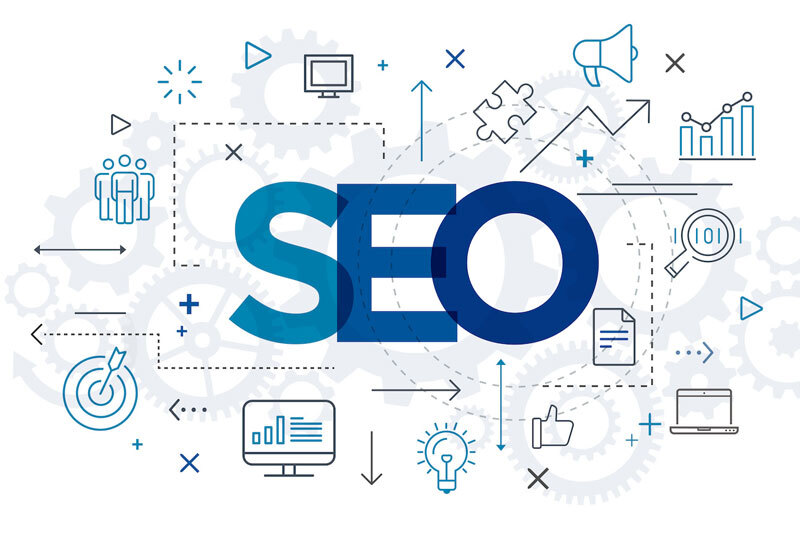Websites are undoubtedly crucial in today’s online space, where visibility is king. As a website owner, you need your site to get to the top of search engine rankings to reach as many individuals as possible. Optimising your webiste is called Search engine optimisation (SEO ) and it is one of the best ways to gain the recognition you seek and reach your target audience. SEO refers to improving the quantity or quality of a site’s traffic from search engines.
The competitive nature of search engine rankings demands that you stay on top of website optimisation as a site owner. Optimising your website ensures that leading search engines like Google can understand it better and rank it higher in SERPs. Fortunately, there is no shortage of things you can do to optimise your website for search.
Our Top SEO Optimisation Tips
Below are some top tips you can leverage to enhance your website for the best results.
Update Your Content
Rich content is, without a doubt, essential to rank higher in search engine results in the first. However, every blog post on your website ages over time and can get lost in the archives. Although these posts may be hidden from people who visit your website currently, Google still finds them regularly. Consequently, you can boost your SEO ranking and site performance by successfully updating and refreshing these existing pages.
Updating your old posts is beneficial because creating new content is typically time-consuming and demanding unless you hire a writing service to keep your site’s content fresh. Therefore, you can simply update your old content to get Google to crawl your website often without having to publish frequently. Your site’s most recent information will be displayed in search results the more Google crawls it so that you can obtain a clear advantage in your rankings.
You can begin updating your content by discovering which posts are worth refreshing in the first place. A quick calculation of each page’s metrics can give you the insights you need to make an informed decision, so keep this in mind. Generally, experts recommend revamping content that gained a lot of attention and shares in the past but is presently enjoying lower traffic and search rank.
Also, content with high traffic but low conversions is worth optimising since it can bring in more leads. Similarly, content with low traffic but high conversions can increase your leads by improving your traffic.
Conduct SEO Keyword Research
Many experts agree that keyword research is the bedrock of all successful website optimisation for search. Therefore, it would be best to understand the present search landscape and the dominating words. This information is critical for one-time optimisation and constant improvement. You can use Google Keyword planner to search for the leading keywords in your location and industry.
This handy tool will offer you various search terms, how frequently they are searched, and how stiff the competition over those words is, based on the number of rival companies purchasing ads based on them. Then, identify all the relevant keywords with high search numbers but low competition and write them down verbatim.
You can incorporate these keywords into all your content as naturally as possible moving forward, so people who are searching for them will be drawn to your site quickly.
Install An SSL Certificate
Google revealed in 2014 that HTTPS encryptions, popularly known as SSL certificates, were crucial to a website’s search ranking. SSL (Secure Sockets Layer) certificates are a popular website security measure. They are small data files hosted on your website’s origin server that allows a safe connection from web servers to browsers.
Essentially, these certificates help your site move from HTTP to HTTPS, making it more secure. Since security and trustworthiness are criteria in Google’s dynamic SEO ranking algorithm, obtaining an SSL certificate for your site is necessary to boost SEO and enhance security simultaneously.
Many website hosting services offer SSL certificates, but Namecheap’s offerings are particularly worth considering because they are more cost-effective and reliable than other SSL providers.
Locate And Fix Broken Links On Your Site
Google ranks sites based on the value they offer to searchers. Therefore, your site will rank lower in results if it contains broken links that offer no value to visitors. Google does this to prevent searchers from following links to your site expecting to see certain content only to be disappointed by them.
Therefore, eliminate or fix all broken links on your website to improve the user experience and boost SEO. If you run a WordPress website, you can install the free Broken Link Checker plugin to search for these links regularly.
This plugin will scan your website thoroughly every three days, and you will receive an email notification if any broken links are found so you can start fixing them promptly. Broken links on your site can be inbound or outbound, so you should pay attention to both types. 404 errors are inbound errors that occur when site content is relocated or removed without the appropriate redirects to guide visitors to the correct page.
You can use a great site crawler to find 404 error pages on your site that might be causing broken links. Then, use 301 redirects to guide visitors to the new page if the content is still on your site but has changed location.
Broken outbound links can be trickier to resolve because you likely don’t have control over any external site you are linking to and might not even realise that content has been relocated or removed from there. Therefore, it is best to audit your outbound links frequently to ensure that you aren’t directing crawlers or people to broken pages.
Improve Page Speed
Patience remains a virtue, but it is in very short supply on the internet these days. Indeed, a study revealed that over 40% of your site’s visitors would leave if it takes more than three seconds to load fully. Also, Google prioritises the user experience above all else.
As such, Google has used page speed as a site ranking factor since 2018, punishing websites that load too slowly since they upset users. Consequently, consider optimising your page speed since this is one of the most reliable on-page SEO tactics you can use.
Fortunately, you can check your website’s speed using Google’s PageSpeed Insights and work on the recommendations it gives you to make your site faster.
Use Calls To Action (CTAs)
A call to action is a persuasive statement that encourages your site visitors to take a specific desired action. You can find CTAs on business websites directing visitors to purchase a product or get in touch to find out more.
However, other websites and blogs employ CTAs for many other purposes, like encouraging site registration and signing up for newsletters. CTAs are a critical aspect of SEO web design because they generate conversions. Therefore, they are undoubtedly worth considering for effective website optimisation.
You can use CTAs to help your audience avoid confusion when visiting your site. Website visitors may want to knock the exact steps necessary to get what they want if they find your offer appealing, and CTAs point them in the right direction.
They also make your site appear more organised, especially if they are few and placed strategically. Experts recommend placing CTAs on every page of your website to create more conversion opportunities, so keep this in mind. Also, place CTAs at the top or bottom of your pages to increase visibility.
CTAs placed in the middle of pages usually have the poorest performance because visitors often check the top of pages and scroll down searching for important words, so they are likely to miss middle-of-the-page placements.
Finally, ensure that your CTAs are large enough and surrounded by whitespace to boost visibility.
Make Your Site Mobile-Friendly
It is estimated that over half of all web traffic originates from mobile devices. Google recognised the popularity of searches from cellphones and introduced its mobile-first indexing policy in 2018 accordingly. This reality implies that Google uses the mobile version of site content for indexing and ranking.
Consequently, making your site mobile-friendly is a critical component of website optimisation that you should prioritise. You can make your site mobile-friendly by using a responsive WordPress theme, so you don’t have to worry about including any additional code.
Also, you can prioritise a mobile-first web design to make your pages easy to navigate and prioritise content over colour.
Additionally, consider resizing your images since this can eliminate up to 80% of the total image size, based on your required dimensions. Furthermore, reduce file sizes with compression to ensure that your images retain their quality despite reducing their file size.
You can also keep your content concise, optimise page speed, simplify your forms, and eliminate pop-ups to make your site more mobile-friendly.
Use Internal Links
Internal links focus on the content on your pages, and they play a significant role in SEO compared to external links that focus on establishing site authority. Your site’s visitors are constantly seeking information, and the core of their experience depends on how you give them this information and whether they can find it easily.
Excellent internal linking is like creating a library for visitors to glance through to facilitate their research. This “library” alerts search engines that your site’s content is an authoritative and exhaustive resource on the keywords, topics, and queries that some searchers are seeking.
Therefore, search engines will give your site the top spots in search results due to your value to searchers. Consequently, include other links on your website in fresh content to create complementary articles that demonstrate your authority in a particular field and rank higher.
Optimise Your Meta Tags
Meta tags are snippets of HTML code that appear in your web pages’ headers. They are essential to SEO because they simplify your web pages’ content for search engines to understand easily. Therefore, it would be best to optimise your meta tag to highlight your website’s most essential content, make your site stand out on search engine results pages (SERPs), and attract more visitors.
Title tags are one of the best meta tags to optimise since they can improve your search engine rankings. Consequently, include your brand’s name and main keywords in your 50-60 characters long title tags, and create a unique page title for each webpage.
Similarly, you can improve your description tag by adding your main keywords and a call-to-action, but remember to keep it 150-160 characters long.
Optimise Your SEO Conversion Funnels
According to experts, the three types of user searches are informational, transactional, and navigational. Consequently, creating and enhancing content for these three search types is critical to rank higher in SERPs.
These searches capture patrons at a specific point in their journey through the funnel, so optimising for all three ensures you don’t miss out on anyone. You can start by studying where your organic searchers visit while on your site to understand where to optimise for the best results.
For instance, if you discover that many site visitors are leaving after visiting your “About” page, you can make this page more enticing. This way, you can enjoy better conversion rates, leads, and sales that can boost your revenue.
Use Readable URLs
Readable URLs are one of the most vital yet neglected SEO features to boost visibility and conversions. A website URL that visitors struggle to read will likely confound search engines as well, so your page URL must be optimised and memorable. Many experts recommend not using capital letters in your URLs, so keep this in mind.
Also, Google does not recognise underscores, so always use hyphens instead. Furthermore, eliminate unnecessary words like index.html from your URL to keep it short and clear. Fortunately, a great plugin can readily help you shorten and redirect lengthy links with unfriendly extensions into more user-friendly ones.
Finally, your website pages need to be clear and descriptive of their offerings. Therefore, introduce some keywords to your URL so search engines can identify your pages and content easily.




